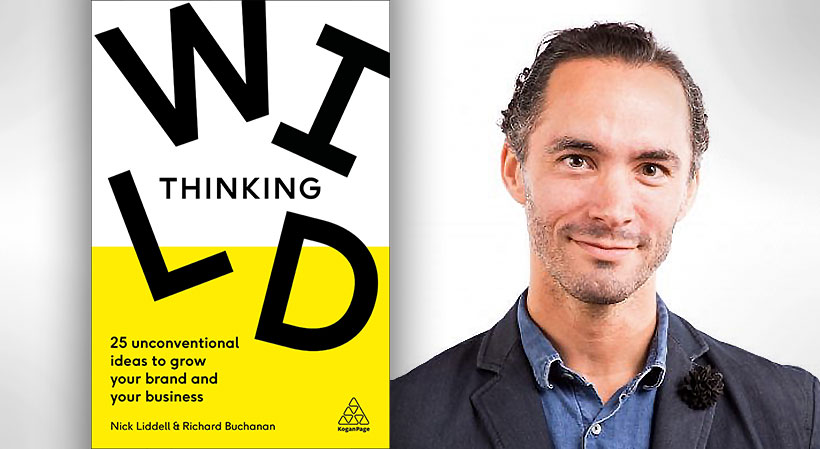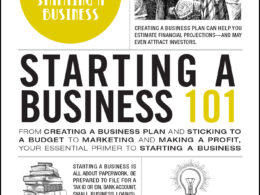The following is adapted from “Wild Thinking” by Nick Liddell and Richard Buchanan ©2019 and reproduced with permission from Kogan Page Ltd.
StartupNation reader exclusive! Save 20 percent on the book with code WILDCARD20 at www.koganpage.com
Marty Neumeier is a big fan of picking fights. “Zag” is his recipe book for making brands radically different, and in it, he encourages his reader to “take on the biggest, most successful competitor you can find.” It’s not about kicking sand in the big guy’s face – it’s about clarifying who you are by defining who you hate. As Neumeier puts it, “David was nothing without Goliath.”
We love an underdog story: Virgin outmaneuvering British Airways; Ben & Jerry’s eating into Häagen Dazs’ market share; Netflix busting Blockbuster. But as compelling as these stories are, there’s a big problem with the underdog narrative in business: every David ultimately wants to become a Goliath, and every Goliath started life as a David. Virgin, Amazon, Ben & Jerry’s and Netflix were all underdogs within recent memory. Now they are the overlords of their categories. They may retain the challenger spirit of their youth, but they carry bazookas instead of slingshots.
Apple is the epitome of the underdog-turned-overlord. No matter how big it gets, the spirit of Steve Jobs seems to have instilled in the business a challenger mentality that inspires the people who work at Apple to ever greater heights of innovation and profitability.
Related: This is the Characteristic You Need to Be a Good Leader
Every hero needs a villain
In these rivalries, Apple has clearly positioned itself in the role of hero.
And every hero needs a villain. There is a gathering weight of evidence that suggests picking the right villain can make a business more compelling to its customers. A 2012 study of Apple Mac users found that the more Apple users identify with the brand, the greater the joy they feel at reports of Microsoft’s misfortunes. This isn’t always a positive thing. A 2007 study into Apple demonstrated that Mac users who identify with the brand don’t just take delight in a rival brand’s misfortunes – they see themselves as different from and superior to users of that rival brand. Rivalry and conflict clearly have the potential to thrill customers, but these rivalries can also be divisive and dehumanizing.
What about the impact of rivalry within a business?
Academic research suggests that finding a villain to vanquish is a potentially powerful motivational tool for managers. A 2010 study into the psychology of competition concluded that rivalries between firms means they are less likely to fall prey to complacency. However, the authors of the study also point out there’s a downside to this type of motivation: it can lead management to prioritize harming competitors over creating shareholder or customer value, discourage management from engaging in cross-sector cooperation in areas such as sustainability and corporate responsibility, and it can encourage a win-at-all-costs mentality that results in unethical behavior or excessive risk taking.
Uber is a case study in excessive competition, having spent much of the past year dealing with the fallout from its history of engaging in precisely these types of behaviors. In January 2017, the company paid $20 million to settle a U.S. federal inquiry into allegations that it misled drivers over how much they would earn. A month later, Susan Fowler published a blog post detailing the toxic, misogynistic atmosphere she was subjected to during her time as an Uber engineer. In the same month, Google’s autonomous vehicle spin-off Waymo sued Uber for “misappropriating” its technology. Uber’s president quit in March, citing “inconsistency” between the company’s values and his own. In April, Uber was exposed for developing a program called “Hell” to spy on arch-rival Lyft and in September the company lost its license to operate in London due to a lack of corporate responsibility.
Taking on a nemesis can be a risky business. It has the power to inspire colleagues, as well as establish a different and desirable brand in the eyes of your customers. But with power comes responsibility: it’s important to choose your nemesis wisely to avoid the “dark” consequences of an adversarial approach to work.
So how do you choose the right nemesis?
McLaren: Focusing on the right enemy
Few environments are more intensely competitive than Formula One and few rivalries are as deep and enduring as McLaren’s with Ferrari. McLaren entered Formula One in 1966 with one simple objective: to challenge Ferrari’s dominance. Marty Neumeier would have approved of their approach. McLaren is the zag to Ferrari’s zig. Where Ferrari is extrovert, flamboyant and expressive, McLaren is studied, measured and exacting. Ferrari prances, while McLaren simply performs.
We visited McLaren’s Technology Centre to meet John Allert, McLaren’s Chief Marketing Officer, to gain an insider’s insight into how a business can use its nemesis to drive performance in such a competitive field. Ferrari is an obvious place to start the conversation:
JOHN ALLERT: If you ask people the question ‘Who is McLaren’s brand nemesis?’ probably most will say Ferrari. The two principal industries that we operate in, Formula One and supercars, rely on a strength of narrative. That narrative is at its best when Ferrari and McLaren are slugging it out against each other. ‘Star Wars’ is nowhere near as interesting if you’ve just got Luke Skywalker; you need both Luke Skywalker and Darth Vader. In both of those industries you could argue that we’re the Darth Vader. We’re not the popular champion. We’re slightly darker, but Darth Vader’s one of the most popular characters in ‘Star Wars.’
I think the other role that the tussle between those brands plays is as a signposting mechanism for people of different values or personality types to identify themselves with one brand or the other. You either like Luke Skywalker or you like Darth Vader. Different brands resonate with different mindsets, and that’s a healthy thing.
The McLaren Technology Centre is as close to a Bond villain’s lair as you’ll find in real life. As the physical embodiment of the brand, the McLaren Technology Centre’s design speaks volumes about the organization’s true nemesis, and it’s not Ferrari:
ALLERT: Most people would say our greatest adversary is Ferrari. But our nemesis to me is a bigger force – and I think that’s mediocrity.
We have traditional foes: Ferrari, other Formula One teams, Aston Martin, road cars, other technology firms. But our nemesis – the thing that worries us most – is letting down ourselves and the premise of our brand through mediocre performances, errors, faults, or even just doing something that’s seen as being average. We’re effectively allergic to mediocrity, and there are all sorts of checks and balances to try to mitigate against that ever happening. The thing that could undo us the most is not Ferrari – it’s mediocrity.
This allergy to mediocrity is the real motivating force behind the brand and its success. It explains the immense care and control with which the McLaren Technology Centre is designed. And it is the arch quality that McLaren seeks in its people:
ALLERT: Fastidious attention to detail. Structure and articulation of thought. An innate sense of ambition. A restlessness to try to better oneself, or the team or the organization that one exists within.
McLaren isn’t the only company in the world to strive toward optimality in everything it does – 13 of the FTSE 100 companies list “excellence” as a value. But McLaren does stand out as one of the few organizations willing to deal with the positive and negative consequences of taking on such a punishing goal. Excellence isn’t something that’s talked about at McLaren. It’s something that is striven toward:
ALLERT: I struggle with the concept of having excellence as a value. Excellence is an outcome. We have values along the lines of openness, humility, courage. They lead you, hopefully, towards that kind of outcome, but to presuppose that as an outcome and state that as a value is, I think, a little conceited and possibly even delusional. Values have the power to lead you to optimal outcomes. Celebrate those values and build a culture that manifests them and you will maximize your chances of achieving that outcome. Just stating the outcome is no way to achieve it.
McLaren’s two principal areas of business, Formula One and supercars, are the very height of luxury. But not every customer demands or is willing to pay for the very best. Not every employee is willing to sacrifice evenings and weekends to work.
Clayton Christensen’s theory of disruptive innovation is based on the idea that most businesses end up producing products or services that are ‘too sophisticated, too expensive, and too complicated for many customers in their market’. The role of disruptive innovators is to undercut and undermine those businesses by developing simpler, cheaper alternatives. Excellence may be an aspirational goal, but it doesn’t always make a business competitive.
Sign Up: Receive the StartupNation newsletter!
A nemesis is not the same as a rival or a foe. Rivalry in business can be a huge cause of distraction; it encourages an organization to glance sideways rather than looking forward. Ferrari isn’t even close to being the biggest threat to McLaren’s future – climate change, technological innovation, population growth and income inequality will play a far more powerful role in the business’s future.
McLaren’s nemesis of mediocrity keeps the business honest and focused on what matters most. It ensures the business stays true to its founder’s ethos at the same time as providing a blueprint for future innovation. Pick your nemesis carefully. It’s not the rival you most keenly want to defeat – it’s the hidden menace that threatens the very existence of your business.
“Wild Thinking” is available now at fine booksellers and can be purchased via StartupNation.com.






